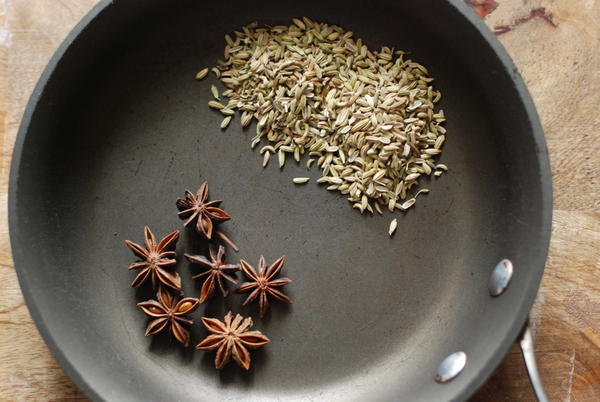A certain one of the two people who inhabit this apartment would like the other one of us to make chicken more often, where the certain one of us is not me, and more often is every day. Alas, we can't always get what we want, if we're not the ones who do the cooking.
But lucky for her, two of our friends had babies in last two weeks, and the holidays have had everyone out of the office, leaving me with loads of downtime and plenty of reasons to cook. So last week, I made a big, tasty mess in the kitchen. I mixed and rolled and baked and oops! ate too many of three batches of cookies, and I made enough mujaddara to feed a medium-sized army, and because the elf on the shelf was watching, I made a big pot of chicken with enough for our friends and D. The best part? It's chicken that smells and tastes like an involved weekend project but comes together like a quick weeknight dinner. Just in time for your New Year's resolution to cook more at home. We know each other well.
I started with a recipe for butternut squash khoresh (stew) from Food of Life, a Persian cookbook whose recipes my Persian friends swear by. Tweak tweak, etc etc. I wound up with something simpler and less fussy: browned chicken, soft butternut squash, and plenty of tang from lime juice and a bit of julienned lime zest. If I hadn't been making it for families with young kids, I might have added some diced fresh red chile. Still, the dish works great as is.
These drumsticks made great dinner one night. The second night, I took the meat off the last two drumsticks and tossed them with some rice and greens for dinner #2. The bones went straight into the freezer, waiting for the weekend to become stock - which I used to cook more of that butternut squash with a little coconut milk. That's stowed away in the freezer for a day not in January where the laziness has set in.
*
I've never been big on New Years resolutions (which is good since it turns out, people rarely keep them). However, I do see this time of year as an opportunity to recommit myself to small but important things I value. For example, over the next few weeks, I'll be bringing Tamar Adler back into my kitchen. I love the way Adler cooks and prepares several basic components in advance, and combines them in different quantities and styles over the course of the week to make eating diversely and excitingly at home a stress-free proposition. If you missed her elegant, dare I say sexy? video on the topic from a couple years ago, it's worth a quick watch. That's my grand plan for Jan.
And then, because we all need a bit of inspiration and aspiration, I've refreshed my Kitchen Resolutions with a bit of a wish list for 2014. If you're up for crossing any of them off my list along with me, let me know. Maybe there's a group project lurking in there somewhere.
January: Let's do this thing, shall we?
More great January fare:
One year ago: Fasolakia, Greek-Braised Green Beans Two years ago: Mujadarra with Spiced Yogurt Three years ago: Mushroom-Pea Curry Four years ago: Crispy Kale Chips (remember when these were brand new?) Five years ago: White Beans with Caramelized Sweet Potatoes Six years ago: Whole Wheat Sables
Chicken with Butternut Squash and Limeinspired by a khoresh recipe from Food of Life serves 6
I made this in a big roasting pan and loved how easy it was to brown the chicken and cook off the stew all in one place, without having to brown the chicken in batches. That said, a heavy-bottomed pot or dutch oven would work well here, too, as long as you make sure to brown the chicken in batches to ensure caramelization.
2 1/2 lbs. drumsticks or other chicken pieces 1 1/2 tablespoons vegetable oil (or substitute canola or olive) 1 teaspoon cinnamon 1 teaspoon tumeric 1 teaspoon sea salt 1 teaspoon pepper 1 red or yellow onion, halved and sliced juice of 3 limes (about 1/4 cup) zest of 1 lime 1 cup water 1 tablespoon brown sugar or honey 6 cups of cubed butternut or kabocha squash (about 1 1/3 lbs.)
Preheat the oven to 375 degrees.
Add oil to a roaster, a heavy-bottomed pot, or a dutch oven, and set over medium-high heat.
Combine cinnamon, tumeric, salt, and pepper in a small bowl. Pat chicken dry and set on a clean plate in a single layer. Sprinkle spice mixture all over chicken.
Brown chicken in a single layer (in batches, if necessary) for about 3 minutes per side, until golden and starting to crisp. If using a pot or dutch oven, remove browned chicken to a plate while you brown the remaining pieces.
If you're using a pot, once you've browned all the chicken, add onions to the pot, toss to coat with drippings, and cook 5 minutes, until some pieces have started to brown. If using a roaster, it's fine to add the onions in once you've flipped the chicken and brown them simultaneously.
Add chicken back to the pot/roaster. Add lime juice and zest, brown sugar/honey, water, and squash. Stir once or twice to combine everything. Cover pot/pan, transfer to the oven, and cook covered with foil for 20 minutes, then another 25-30 minutes uncovered, until everything is cooked through and juices are bubbling.
Serve immediately, or reheat in a 350-degree oven for 10-15 minutes before serving.




















